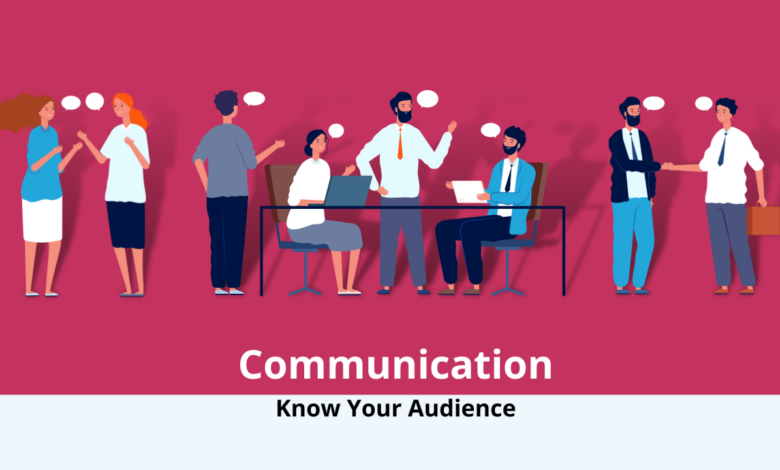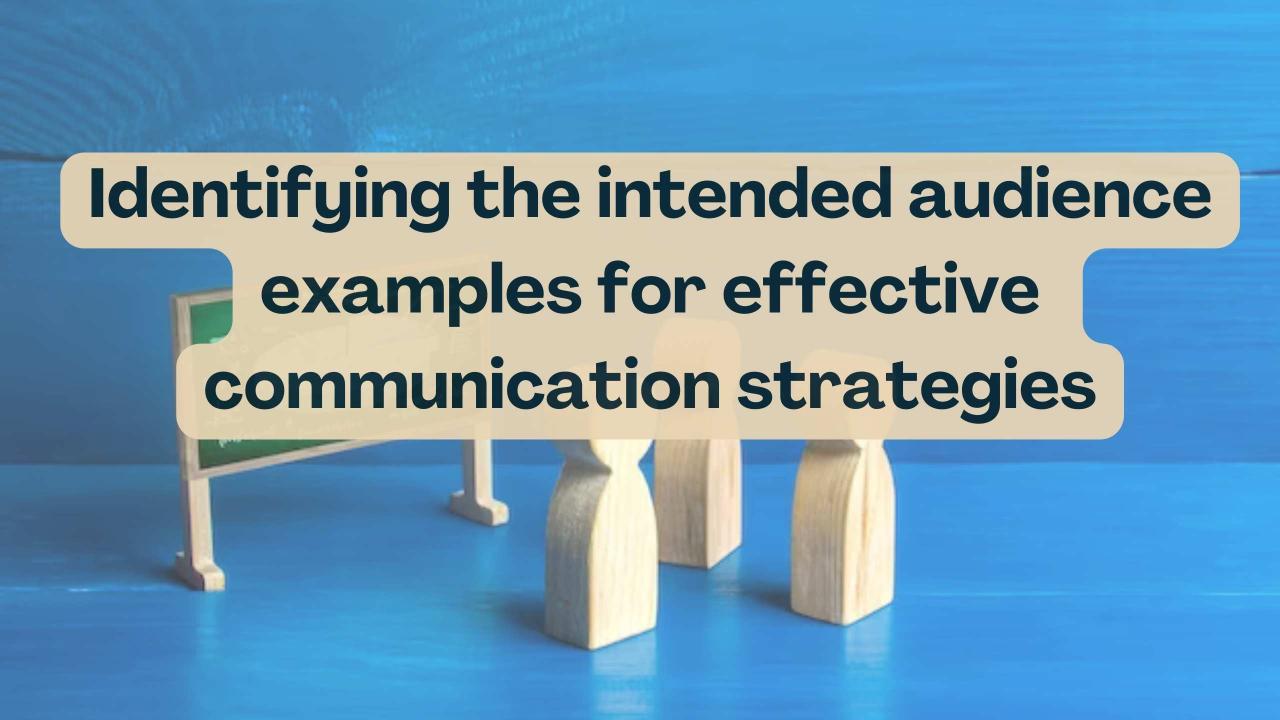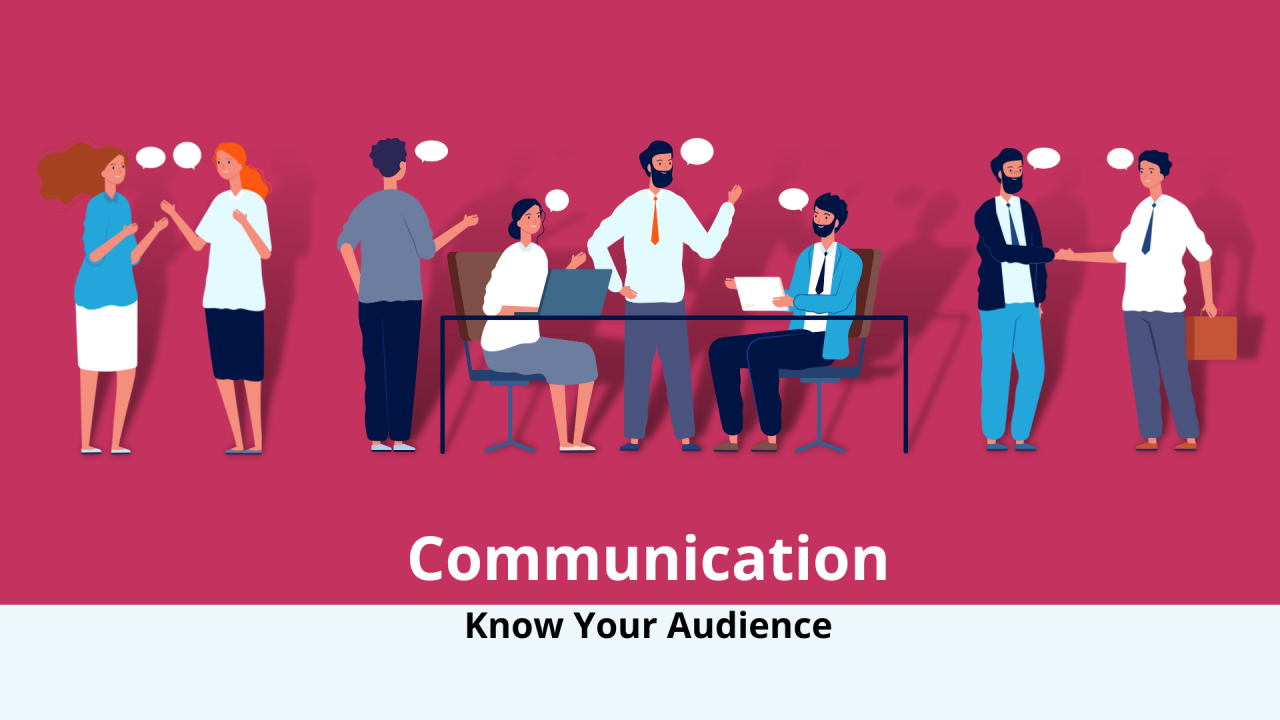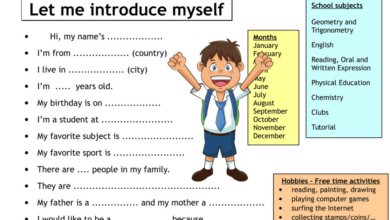
Know Your Audience Communications Foundation
Know your audience still the best starting point for your communications. Understanding your audience is the cornerstone of effective communication. Whether you’re crafting marketing materials, delivering presentations, or simply connecting with colleagues, knowing your audience deeply allows you to tailor your message for maximum impact. This goes beyond basic demographics; it delves into their needs, preferences, and the best channels for reaching them.
This exploration will uncover the vital steps in identifying, understanding, and adapting to diverse audiences. We’ll discuss various communication channels and how to choose the right ones for specific audiences. Ultimately, knowing your audience is not just about effective communication; it’s about building stronger relationships and fostering trust.
Understanding Audience Needs
Knowing your audience is crucial for effective communication. It’s not enough to simply broadcast a message; you need to tailor it to resonate with the specific needs and expectations of your target group. This requires a deep dive into understanding the unique characteristics, preferences, and communication styles of different segments within your audience.This involves more than just demographics; it’s about recognizing the motivations, concerns, and pain points that drive their interactions with your brand or message.
Understanding these nuances allows for crafting more compelling and impactful content, leading to increased engagement and desired outcomes.
Diverse Audience Segments and Their Needs
Different audience segments have distinct communication needs. For example, a tech-savvy millennial might prefer concise, visually engaging content delivered through social media platforms. Conversely, a seasoned professional might favor detailed, well-researched articles or presentations. Similarly, parents might prioritize information on practicality and reliability, while students may seek quick, digestible summaries and clear explanations.Consider the specific needs of each segment.
Older adults might need clear, large-font text, while visually impaired audiences may require alternative formats like audio descriptions or transcripts. These examples highlight the importance of tailoring your communication to accommodate various needs and preferences.
Identifying Unique Characteristics of Audience Segments
Understanding the specific characteristics of each audience segment is key. This can involve analyzing demographics (age, location, gender, income), psychographics (values, interests, lifestyles), and behavioral patterns (online activity, purchasing habits). Data on their preferred communication channels, language preferences, and typical information consumption habits is essential.
Gathering Data on Audience Preferences and Expectations
Gathering data on audience preferences and expectations is crucial. Surveys, focus groups, and social media listening tools can provide insights into what resonates with different segments. Analyzing website analytics and customer feedback can also reveal patterns and trends in communication preferences. For instance, analyzing website click-through rates and time spent on specific pages can indicate which aspects of your communication are most engaging.
Qualitative data, like open-ended survey questions or focus group discussions, can uncover deeper motivations and concerns.
Communication Channels and Suitability for Different Segments
| Communication Channel | Suitability for | Example Use Cases |
|---|---|---|
| Social Media (Facebook, Twitter, Instagram) | Millennials, Gen Z, and tech-savvy audiences | Product announcements, contests, behind-the-scenes content |
| Email Newsletters | Professionals, older adults, those seeking in-depth information | Industry news, product updates, educational resources |
| Blog Posts/Articles | Professionals, students, and those seeking detailed information | Detailed explanations of complex topics, research summaries |
| Webinars/Online Events | Professionals, students, and anyone seeking interactive learning experiences | Expert presentations, Q&A sessions, product demos |
| Print Materials (Brochures, Pamphlets) | Older adults, those preferring tangible information | Detailed product information, instructions, maps |
This table Artikels a general guideline; specific suitability can vary based on the particular content and target audience. Consider the context and desired outcome when selecting a communication channel.
Tailoring Messages for Impact: Know Your Audience Still The Best Starting Point For Your Communications
Knowing your audience is crucial, but truly effective communication goes beyond understanding their needs. It’s about tailoring your message to resonate deeply with them, adapting your approach to create a powerful connection. This involves more than just selecting the right words; it’s about understanding how to craft a message that speaks directly to the heart of your target audience.
This often means adjusting your language, tone, and even visual elements to ensure maximum impact.Crafting impactful communication requires a nuanced understanding of how different audiences receive information. Adapting your style to match the audience’s preferences is essential for effective engagement and achieving your communication goals. Understanding the subtleties of language, tone, and visual elements allows you to speak directly to your audience’s values, beliefs, and priorities, which are often intertwined with their demographics.
Adapting Communication Style
Different audiences respond to different communication styles. Formal settings often demand a more structured and precise approach, while informal interactions benefit from a more conversational and engaging tone. Recognizing these differences is paramount to crafting effective communication. Tailoring your style not only enhances engagement but also fosters trust and understanding.
Adjusting Language, Tone, and Visuals, Know your audience still the best starting point for your communications
Language, tone, and visuals play crucial roles in tailoring messages. The language you use should be appropriate for the audience’s level of understanding and familiarity with the subject matter. A formal audience might appreciate more complex terminology, while a less formal audience might respond better to simpler, more accessible language. The tone should also align with the audience’s expectations.
A serious topic demands a serious tone, while a lighter subject can allow for a more casual and engaging approach. Visual elements, like images, infographics, or videos, should complement the message and enhance its impact, rather than detracting from it. They should be carefully selected to be both visually appealing and relevant to the audience’s interests. For example, a presentation to investors might include data-driven charts, while a presentation to a younger audience might feature engaging graphics and animations.
Knowing your audience is still the best starting point for any communication strategy, no matter the subject. Take, for example, Oshkosh’s plans for new development near the Fox River, as detailed in this recent article oshkosh eyes new development near fox river. Understanding the local community’s needs and desires is crucial for success, whether it’s a city council project or a social media campaign.
Ultimately, knowing your audience remains the bedrock of effective communication.
Comparing Communication Approaches
| Audience | Communication Approach | Language | Tone | Visuals |
|---|---|---|---|---|
| Formal (e.g., executives, academics) | Structured, precise, and professional | Formal, precise vocabulary | Serious, respectful, and authoritative | Clean, minimalist design; data-driven charts |
| Informal (e.g., colleagues, friends) | Conversational, engaging, and friendly | Casual, relatable language | Enthusiastic, approachable, and supportive | Modern, engaging designs; relevant imagery |
| Technical (e.g., engineers, scientists) | Detailed, technical, and data-driven | Jargon and technical terms | Objective, factual, and logical | Complex diagrams and illustrations; graphs |
| Creative (e.g., artists, designers) | Inspirational, evocative, and imaginative | Figurative language, metaphors | Enthusiastic, passionate, and inspiring | Visually stimulating images, colors, and layouts |
Empathy in Crafting Effective Messages
“Understanding and sharing the feelings of another.”
Empathy is critical in crafting effective messages. By stepping into the shoes of your audience, you can anticipate their needs and concerns. This allows you to create messages that are not only informative but also resonate with their values and experiences. Empathy isn’t about becoming someone else; it’s about recognizing their perspective and tailoring your communication accordingly.
This approach fosters trust, understanding, and ultimately, more effective communication.
Measuring Communication Effectiveness
Knowing your audience is crucial, but truly understanding their response to your communication requires careful measurement. Effective communication isn’t just about crafting the right message; it’s about ensuring that message resonates and achieves its intended goals. This involves a systematic approach to tracking engagement and gauging impact.Measuring communication effectiveness goes beyond simple impressions. It delves into the specific actions and attitudes your audience demonstrates in response to your communications.
This allows for continuous improvement and a more nuanced understanding of how your messages are received. Crucially, data-driven insights empower informed decisions, ensuring your resources are allocated efficiently and maximizing the impact of your efforts.
Knowing your audience is still the best starting point for any communication strategy, whether it’s crafting a marketing campaign or advocating for environmental protection. For example, the Fox Wolf Watershed Alliance, a great organization focused on sustaining our waters , clearly understands the needs and concerns of their community, which allows them to effectively target their message. Ultimately, understanding your audience remains crucial for successful communication, no matter the subject.
Key Metrics for Tracking Success
Identifying the right metrics is paramount to assessing the success of your communications. Different communication goals necessitate different metrics. For instance, a campaign aimed at driving sales will prioritize conversion rates, while one focused on brand awareness might emphasize social media engagement. Understanding the intended outcome of your communication is essential for selecting appropriate metrics.
- Website traffic and engagement metrics (e.g., page views, time on site, bounce rate)
- Social media engagement metrics (e.g., likes, shares, comments, follower growth)
- Lead generation metrics (e.g., number of leads generated, conversion rates from leads to customers)
- Sales figures and revenue generated (for sales-oriented communications)
- Brand mentions and sentiment analysis (for brand awareness campaigns)
Methods to Evaluate Audience Engagement and Response
Evaluating audience engagement and response requires a multi-faceted approach. Employing various methods provides a comprehensive picture of audience reaction and allows for a more holistic evaluation. This often involves gathering feedback from multiple sources.
- Surveys: Structured questionnaires can gather quantitative and qualitative data about audience perceptions, preferences, and behaviors. Open-ended questions allow for deeper understanding of sentiment and motivations.
- Focus groups: Group discussions offer insights into how audiences interpret and react to communication materials. These provide valuable context and nuance to quantitative data.
- A/B testing: Comparing two versions of a message or campaign allows you to identify which performs better. This data-driven approach optimizes communication strategies for maximum impact.
- Tracking website analytics: Monitor user behavior on your website to understand how audiences interact with your content. This provides insights into areas needing improvement or adjustments.
- Customer feedback: Collecting feedback from customers through various channels, such as reviews and feedback forms, reveals their experiences and satisfaction with your communication.
Table of Communication Effectiveness Measurement Methods
The following table summarizes different methods for measuring communication effectiveness, categorized by the type of data they provide.
| Method | Data Type | Example |
|---|---|---|
| Surveys | Quantitative and Qualitative | “How satisfied are you with our recent campaign on a scale of 1 to 5?” “What were your thoughts on the new logo?” |
| Focus Groups | Qualitative | Discussions about the effectiveness of a new marketing campaign, gathering insights on user perceptions and feedback. |
| A/B Testing | Quantitative | Comparing conversion rates of two different ad copy versions to identify the most effective one. |
| Website Analytics | Quantitative | Tracking page views, bounce rate, time spent on pages to understand user engagement with website content. |
| Customer Feedback | Qualitative and Quantitative | Collecting customer reviews on social media and company website. Using rating systems to measure satisfaction. |
Data Visualization for Audience Engagement Trends
Visual representations of data are crucial for identifying trends and patterns. Clear visualizations make complex information easily digestible.
- Line graphs: Illustrate trends over time, such as website traffic growth or social media engagement rates. They visually showcase progress or decline in key metrics.
- Bar charts: Compare different categories or groups, like different social media platforms or campaign variations, by highlighting differences in metrics like likes or shares.
- Pie charts: Show the proportion of different elements within a whole, for instance, the breakdown of sources of website traffic or the distribution of engagement across demographics.
- Heatmaps: Highlight areas of high or low engagement on a website, enabling targeted improvements to user experience.
Staying Updated with Audience Shifts
Staying ahead of the curve in communication requires a constant understanding of your audience. This isn’t a one-time exercise; audience preferences and behaviors are dynamic. Knowing how to adapt your communication strategy to these shifts is critical for maintaining engagement and achieving your goals. Successful communication hinges on continuous research and analysis to track these evolving patterns.Audience needs, preferences, and communication styles are constantly in flux.
The digital age accelerates these changes, creating a dynamic landscape where traditional methods of understanding your audience might become outdated quickly. Staying relevant requires a proactive approach to understanding and responding to these evolving patterns.
Ongoing Audience Research and Analysis
Understanding audience dynamics is an ongoing process. Regular research and analysis provide valuable insights into changing trends. This includes surveys, focus groups, social media monitoring, and analyzing website analytics. Gathering and analyzing data from these diverse sources offers a comprehensive view of your audience’s current needs and interests. These insights allow for proactive adjustments to your communication strategy.
Monitoring Evolving Audience Preferences and Trends
Monitoring social media conversations, industry news, and competitor activities helps in identifying emerging trends and shifts in audience preferences. Tools like social listening platforms can provide real-time feedback on how your audience perceives your messages and how their opinions are changing. Staying informed about industry trends and competitor strategies allows you to proactively adjust your approach to maintain a competitive edge.
Documenting Changes in Audience Behavior and Communication Styles
Maintaining a comprehensive record of audience behavior changes is essential. A dedicated document or database can track shifts in preferred communication channels, content formats, and engagement patterns. This document should include specific examples of how the audience is interacting with your communications, what types of content resonate the most, and what platforms are driving the highest engagement. This structured approach provides a clear picture of audience evolution.
For example, a table could list the communication channel, the frequency of use, and the level of engagement.
Adapting Communication Plans to Keep Pace with Audience Evolution
Adapting communication plans requires a flexible approach. A proactive strategy includes regularly reviewing and updating your communication plan to reflect the changing needs and preferences of your audience. This involves adjusting content formats, channels, and messaging to align with the audience’s current communication style. For instance, if your audience is shifting towards video content, incorporating more videos into your communication plan would be a strategic move.
The ability to respond to these shifts is key to maintaining audience engagement and achieving desired outcomes.
The Value of Knowing Your Audience

Understanding your audience isn’t just a good practice; it’s fundamental to effective communication. Ignoring audience needs can lead to wasted resources, misinterpretations, and ultimately, a disconnect with your target market. A deep understanding of who you’re communicating with allows you to tailor your messages for maximum impact and build stronger relationships. This, in turn, fosters brand loyalty and a positive reputation.Knowing your audience is not simply about demographics.
It’s about understanding their motivations, pain points, values, and how they consume information. This deeper understanding allows you to craft communications that resonate, encouraging engagement and action.
Benefits of Focusing on Audience Needs
Focusing on audience needs in communication yields numerous benefits. These benefits extend far beyond simple message delivery, encompassing a significant improvement in overall brand perception. Understanding audience needs creates a connection between the brand and the customer, fostering loyalty and trust.
- Improved Engagement: Tailored messages are more likely to capture attention and spark interest. When a communication directly addresses an audience’s concerns or needs, it naturally fosters a stronger connection and increased engagement. For example, a company selling eco-friendly products that targets environmentally conscious consumers is more likely to resonate with their audience than one that doesn’t.
- Higher Conversion Rates: Communications designed with the audience in mind are more effective at persuading them to take action, whether that’s making a purchase, signing up for a newsletter, or visiting a website. A message that directly addresses a customer’s need for a specific product or service is more likely to result in a conversion than one that is generic and unfocused.
- Stronger Brand Reputation: Consistency in delivering valuable content and addressing audience needs enhances brand reputation. When a brand consistently demonstrates an understanding and consideration of its audience, it fosters trust and positive perception.
Comparing Outcomes of Audience-Centric vs. Non-Audience-Centric Communication
The difference in outcomes between communications that consider the audience and those that don’t is stark. A clear understanding of your target audience can lead to measurable improvements in a variety of key performance indicators (KPIs).
| Characteristic | Audience-Centric Communication | Non-Audience-Centric Communication |
|---|---|---|
| Engagement | High engagement, active participation, and strong response rates. | Low engagement, limited response, and potentially negative feedback. |
| Conversion Rates | High conversion rates, leading to increased sales and leads. | Low conversion rates, resulting in wasted resources and lost opportunities. |
| Brand Perception | Positive brand image, strong brand loyalty, and increased customer advocacy. | Negative brand image, decreased brand loyalty, and reduced customer trust. |
How Audience-Centric Communication Enhances Brand Reputation
A brand’s reputation is built on trust and reliability. When communications are audience-centric, the brand demonstrates a genuine interest in understanding and meeting the needs of its customers. This fosters a sense of connection and reliability.
- Building Trust: Showing empathy and consideration for audience needs builds trust. When a brand demonstrates that it values its customers, it creates a more positive and trustworthy brand image.
- Positive Word-of-Mouth: Satisfied customers are more likely to recommend a brand to others. When brands prioritize audience needs, they foster positive experiences that translate into positive word-of-mouth referrals.
- Increased Customer Loyalty: A strong connection with customers leads to greater loyalty. Companies that demonstrate an understanding of their audience cultivate customer loyalty, increasing their lifetime value.
How Audience-Centric Communication Leads to Stronger Relationships
Audience-centric communication fosters stronger customer relationships by demonstrating understanding and valuing customer needs.
- Enhanced Customer Experience: Understanding the audience allows for the development of products and services that meet their needs, thereby enhancing their experience with the brand.
- Improved Customer Retention: By addressing customer needs effectively, companies can create positive experiences that keep customers engaged and coming back.
- Increased Customer Lifetime Value: Strong customer relationships and consistent positive experiences translate to higher customer lifetime value for the company.
Communication Channels and Audiences
Knowing your audience is crucial, but knowing
- how* to reach them is equally important. Effective communication hinges on selecting the right channels to connect with specific audience segments. This involves understanding not just who you’re talking to, but also
- where* they spend their time and how they prefer to receive information. Different communication channels resonate with different audience preferences, and matching the channel to the message and audience is key to maximizing impact.
Optimal Channels for Different Audience Segments
Choosing the right communication channel is essential for ensuring your message resonates with the intended audience. The channel should align with the audience’s preferred methods of receiving information, and their typical engagement patterns. This selection should be tailored to the specific audience segment, taking into account their demographics, interests, and technological literacy.
Knowing your audience is still the best starting point for any communication strategy, no matter the context. Take, for example, the Stevens Points Breast Care Center’s recent redesignation, a testament to focusing on the needs of their community. By understanding their patients’ needs and preferences, they’ve clearly demonstrated the importance of tailoring communication to resonate with their target audience.
This ultimately ensures that their message effectively connects with those they serve. Ultimately, knowing your audience remains the foundation for impactful communication. Stevens Points Breast Care Center receives redesignation is a prime example of this.
| Audience Segment | Ideal Communication Channels | Rationale |
|---|---|---|
| Millennials and Gen Z | Social Media (Instagram, TikTok, Snapchat), Short-Form Video Platforms, Interactive Content (Quizzes, Polls) | These generations are highly active on social media and prefer visually engaging content. They often seek quick, easily digestible information. |
| Baby Boomers and Gen X | Email, Newsletters, Webinars, Direct Mail | These generations often prefer more traditional methods of communication. Email and newsletters are reliable and easily accessible. |
| Professionals in Specific Industries | Industry-Specific Forums, LinkedIn, Webinars, Email Newsletters | These audiences often congregate in specific online communities. Leveraging platforms where they already engage allows for targeted messaging. |
| Customers seeking product support | Live Chat, Email, Phone Support | Direct communication channels are essential for addressing immediate concerns and resolving issues. |
| Large, Diverse Audiences | Combination of Channels (Email, Social Media, Website Articles) | Using a combination of channels ensures the message reaches the widest possible audience. |
Selecting the Right Channels for a Specific Message
Effective communication strategy relies on carefully selecting the channels that best suit the specific message and the target audience. The choice should not be arbitrary, but rather, based on a thorough understanding of the audience’s preferences and the message’s characteristics. Consider the following factors when choosing channels:
- Message Complexity: A complex message might benefit from a detailed explanation on a website, while a simpler message can be conveyed effectively through a social media post.
- Audience Engagement Level: Highly engaged audiences might respond positively to interactive content like polls or quizzes, while less engaged audiences might require a more direct approach, such as email newsletters.
- Message Tone: The tone of the message influences the channel selection. A formal announcement might be better suited for email, while a promotional campaign might use a variety of channels like social media and email.
- Desired Outcome: If the goal is to drive sales, social media or targeted advertising campaigns might be more effective than a webinar. If the objective is brand awareness, a combination of channels across various platforms is often more suitable.
Building Relationships Through Communication

Knowing your audience isn’t just about understanding their demographics or preferences; it’s about forging genuine connections. Effective communication, tailored to individual needs and motivations, is the cornerstone of strong relationships. This goes beyond transactional exchanges and moves towards building trust, loyalty, and lasting engagement. A deep understanding of your audience allows for proactive and empathetic communication strategies.Building rapport with your audience is a two-way street.
It requires an understanding of their values, concerns, and aspirations. When you can communicate in a way that resonates with their unique needs, you foster a sense of belonging and mutual respect. This, in turn, creates the foundation for stronger relationships, increased loyalty, and amplified brand advocacy.
Tailored Communication Builds Trust and Loyalty
Tailored communications, specifically designed to address the unique needs of different audience segments, significantly contribute to building trust and loyalty. When individuals feel understood and valued, they are more likely to engage with your brand and develop a strong connection. This personalized approach goes beyond generic messages and creates a more meaningful interaction.
Examples of Successful Relationship-Focused Strategies
Several companies have demonstrated success in building strong relationships through tailored communication. For example, Patagonia, known for its environmental advocacy, resonates with customers who share similar values. Their communication often highlights sustainability initiatives and emphasizes the long-term impact of their products. This resonates with their target audience, fostering loyalty and driving advocacy. Another example is the way companies like Netflix use data to understand individual viewing habits and recommend content tailored to each user.
This personalized experience increases user engagement and satisfaction. These examples demonstrate that a focus on understanding and responding to individual needs can lead to significant positive outcomes.
Creating Personalized Communication Experiences
Personalizing communication involves segmenting your audience based on shared characteristics, interests, and behaviors. This allows you to tailor your messaging to resonate with specific groups. For instance, you might create different email campaigns for customers who have made recent purchases, those who haven’t interacted with your brand in a while, or those who have expressed interest in specific products.
By understanding the unique needs of each segment, you can develop targeted messaging that addresses their concerns and aspirations. This includes using personalized greetings, recommending products based on past purchases, and offering exclusive content tailored to specific interests. The key is to create a sense of individual connection and value.
Example Communication Strategies
Knowing your audience is crucial, but translating that knowledge into effective communication strategies is equally important. This involves tailoring your approach to resonate with different segments of your audience, understanding the most impactful communication channels, and measuring the effectiveness of your efforts. A well-defined strategy, built on audience insights, can dramatically improve the impact of your messages.
Framework for Designing Effective Communication Strategies
A robust communication strategy begins with a clear understanding of your objectives. What do you want to achieve? Increased brand awareness? Product adoption? Driving sales?
Once your objectives are defined, you can identify the target audience segments most relevant to those goals. Next, develop key messages that align with these objectives and resonate with the target audience’s needs and values. Finally, choose the appropriate communication channels to deliver your message effectively. This may involve multiple channels for maximum reach and impact.
Consider the strengths of each channel in relation to your target audience’s preferences.
Different Communication Strategies Aligned with Audience Segments
Different audience segments often respond best to varied communication approaches. For example, a younger audience might be more receptive to interactive content like social media posts or videos, while a more established professional audience might favor detailed articles or webinars. Tailoring your message to the specific characteristics and needs of each audience segment is essential for achieving the desired outcome.
This means considering factors like age, occupation, interests, and cultural background.
Table Presenting Communication Strategies and Target Audiences
| Communication Strategy | Target Audience | Description |
|---|---|---|
| Social Media Campaigns | Gen Z, Millennials | Utilizing platforms like Instagram, TikTok, and Facebook to engage through visually appealing content, interactive polls, and influencer collaborations. |
| Email Marketing | Professionals, established customers | Building relationships through targeted content, product updates, and valuable resources. |
| Print Advertising | Older demographics, geographically focused | Reaching specific regional or age-based communities through local newspapers and magazines. |
| Webinars and Online Events | Professionals seeking knowledge and information | Offering in-depth sessions with industry experts on relevant topics, fostering a sense of community. |
| Public Relations | Wider audience, media-savvy individuals | Building brand reputation through media coverage, press releases, and influencer outreach. |
Case Study: Successful Communication Campaign Prioritizing Audience Understanding
A well-known fitness brand, “FitLife,” launched a campaign focused on encouraging healthy lifestyle choices among young adults. They conducted extensive research to understand the specific concerns and motivations of this demographic. They discovered that young adults valued social connection and convenient options. Their campaign, therefore, focused on social media platforms and emphasized user-generated content, featuring success stories from other users and highlighting the convenience of their fitness app.
The campaign was remarkably successful, generating a significant increase in app downloads and user engagement. This success directly resulted from the brand’s deep understanding of their target audience’s needs and preferences. The campaign exemplified how a clear understanding of the target audience can translate into impactful and effective communication strategies.
Final Conclusion
In conclusion, prioritizing audience understanding is paramount in achieving successful communication. By tailoring your messages, selecting the right channels, and adapting to evolving audience needs, you can maximize the impact of your communications. Remember, a deep understanding of your audience is the key to building strong relationships, fostering trust, and achieving lasting results.




